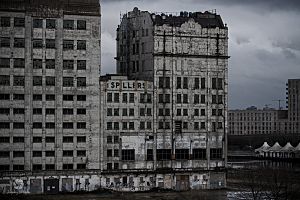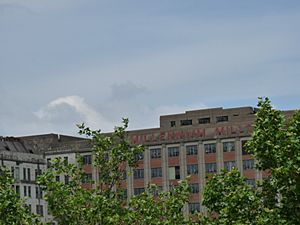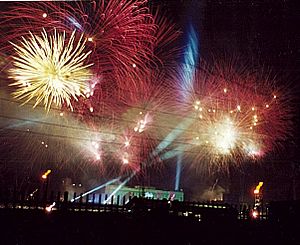Millennium Mills facts for kids

The Millennium Mills is an old flour mill building in West Silvertown, London. It's located on the south side of the Royal Victoria Dock, near the Thames Barrier and the ExCeL London exhibition centre. This historic building is currently being completely updated as part of a huge £3.5 billion project to rebuild the Silvertown area.
Next to Millennium Mills, you can still see a small part of the Rank Hovis Premier Mill, which was mostly destroyed. There's also a restored grain silo called the 'D’ silo, which is a protected historic building. The Millennium Mills has become a famous symbol of Britain's industrial past. It has appeared in many films and TV shows, like Ashes to Ashes and London's Burning. Even though it was empty and risky to enter, it was a popular spot for "Urban Explorers" who like to visit abandoned places.
Contents
History of the Millennium Mills
In the early 1900s, the Royal Victoria Dock became a very important industrial area. It was London's biggest centre for making flour. Because it had good links for both rail and water transport, it was a perfect spot for businesses and international trade.
The Cooperative Wholesale Society (CWS) was the first big flour company to open a mill here in 1901. Then, Joseph Rank Limited opened their Premier Mill in 1904. Finally, Vernon & Sons built the Millennium Mills. These mills were run by Britain's three largest milling companies. They turned imported grain from other countries into flour for London. They were the first mills in the Port of London designed to take grain directly from ships.
Millennium Mills was designed by William Vernon & Sons from Birkenhead in 1905. The mills were very large and could process 100 sacks of flour every hour. Vernon & Sons named the mill after their most successful product, a type of flour called "Millennium Flour." This flour won a special award in 1899 and was known for making "beautiful white bread sandwiches." Building the Millennium Mills at the Royal Victoria Dock helped bring this popular flour to Southern England.
In 1917, a big explosion happened at a nearby factory during World War I. This factory was making explosives. The explosion badly damaged all the mills, including Millennium Mills.
In 1920, Spillers Limited took over Vernon & Sons and bought Millennium Mills. Spillers was an old flour milling company that later started making dog food. You can still see the Spillers name on the building today.
Millennium Mills was rebuilt in 1933 as a tall, 10-story concrete building with an Art Deco design. During World War II, many port mills were bombed, including Millennium Mills and Rank's Premier Mills. After the war, between 1945 and 1950, Millennium Mills was rebuilt again and was working by 1953.
Closure and Earlier Plans
The Royal Docks closed in 1981, and many businesses moved away. In the 1990s, there were talks about building a public aquarium on the site of the old CWS mill, but the idea didn't happen. The Rank and CWS mills were torn down in the 1990s, along with some parts of Millennium Mills. However, the 'D' silo is a protected historic building, and Millennium Mills itself is also recognized as an important local landmark.
In 2001, a plan was suggested to rebuild the old docklands area. By 2007, a huge £1.5 billion project was approved. This plan aimed to turn the area into a mix of homes, shops, and public spaces. It was expected to create 2,000 jobs. The plan included building 4,900 homes along the waterfront. The idea was to turn the Millennium Mills building into 400 fancy apartments. There were also plans for a new aquarium called Biota!.
However, this big building project faced problems. By 2009, no work had started. The London Development Agency (LDA) eventually cancelled the agreement because the company couldn't get enough money for the project.
Around 2011, the building was still empty. It was a popular place for "Urban Explorers" who like to explore abandoned buildings. Many photos and stories from inside the building exist from this time.
In 2012, the Millennium Mills area was used for the London Pleasure Gardens, which opened for the London Olympics. It was supposed to host music and arts events for three years. But the site had problems from the start, with visitors saying it wasn't finished and wasn't safe. The project closed after only five weeks, costing the local council £4 million.
New Redevelopment Plans
On April 21, 2015, the local council approved a new £3.5 billion plan to rebuild the area, including Millennium Mills. The building is set to become a hub for new businesses.
Work began in January 2015 to clean the building and remove old materials like asbestos. The government provided £12 million to start this work. Important officials, like communities minister Penny Mordaunt and London's deputy mayor for housing, visited the site.
Penny Mordaunt said that many people working there would be able to live in the area. She added that the "iconic building will be the centrepiece of a thriving new business district." The Mayor of London, Boris Johnson, also said that restoring the building was "another vital ingredient in the regeneration of London's historic Royal Docks."
In September 2015, the mills were opened to the public for a special weekend event. Visitors could explore parts of the building. By then, the inside machinery and grain chutes had been removed, and some of these old parts were planned to be given to artists.
Millennium Mills in Popular Culture
The Millennium Mills building has been used as a setting in many films, TV shows, and music videos because of its unique, old look.
In 1985, the nearby CWS mill was used in Terry Gilliam's film Brazil. It appeared as the "Department of Records" and other parts of a tall building.
Derek Jarman's The Last of England
In 1987, British filmmaker Derek Jarman made his film The Last of England, using Millennium Mills as a key location. Jarman described the area as "miles of desolation." In one scene, characters are shown dancing on the roof of the empty Millennium Mills building.
Jean-Michel Jarre's Destination Docklands
For his 1988 concert Destination Docklands, musician Jean-Michel Jarre had Millennium Mills painted white. This made it a perfect surface for projecting amazing lighting effects. The concert was about the Industrial Revolution and the move into the information age, which fit well with the abandoned docklands.
Other Media Appearances
Millennium Mills was a common filming spot for the British TV series Ashes to Ashes (2008–2010). It appeared in the very first episode. The show is set in the 1980s, and using the mills helped show what London looked like before big changes happened.
The mills also appeared in an episode of London's Burning, where it was the scene of a rescue.
It was used in the 2010 film Green Zone and the 2012 thriller Twenty8K.
Many music videos have been filmed at Millennium Mills, including:
- "Ask" by The Smiths (1986)
- "The Box" by Orbital (1996)
- "Fluorescent Adolescent" by the Arctic Monkeys (2007)
- "Take Back the City" by Snow Patrol (2008)
- "Build A Fire" by Lamb (2011)
- "Every Teardrop Is a Waterfall" by Coldplay (2011)
In 2013, scenes for the movie The Man From U.N.C.L.E. and Danny Boyle's film Trance were shot there.
In 2016, part of "YouTube Rewind: The Ultimate 2016 Challenge" was filmed at Millennium Mills.
The building also appeared briefly in the 2017 film Paddington 2 and the 2018 Netflix TV show The Innocents.
In 2018, Millennium Mills was used for scenes in the TV series Informer.
In 2020, it appeared in the first episode of the IMDb series Alex Rider.
In 2022, it appeared in the movie The Batman.






